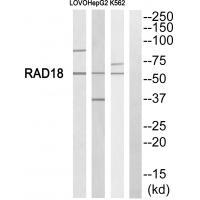
| WB | 咨询技术 | Human,Mouse,Rat |
| IF | 咨询技术 | Human,Mouse,Rat |
| IHC | 咨询技术 | Human,Mouse,Rat |
| ICC | 技术咨询 | Human,Mouse,Rat |
| FCM | 咨询技术 | Human,Mouse,Rat |
| Elisa | 咨询技术 | Human,Mouse,Rat |
| Aliases | E3 ubiquitin-protein ligase RAD18; hHR18; hRAD18; postreplication repair protein hRAD18p; Postreplication repair protein RAD18 |
| Entrez GeneID | 56852; |
| WB Predicted band size | 56kDa |
| Host/Isotype | Rabbit IgG |
| Antibody Type | Primary antibody |
| Storage | Store at 4°C short term. Aliquot and store at -20°C long term. Avoid freeze/thaw cycles. |
| Species Reactivity | Human |
| Immunogen | Synthesized peptide derived from internal of human RAD18. |
| Formulation | Purified antibody in PBS with 0.05% sodium azide. |
+ +
以下是3篇关于RAD18抗体的参考文献及其摘要概括:
---
1. **文献名称**: "RAD18 transmits DNA damage signaling to elicit homologous recombination repair"
**作者**: Huang J. et al. (2009)
**摘要**: 该研究利用RAD18特异性抗体,通过免疫沉淀和Western blot技术,揭示了RAD18在DNA复制胁迫下通过单链DNA(ssDNA)结合及泛素化修饰,促进复制叉重启和同源重组修复的分子机制。
2. **文献名称**: "Rad18 guides poleta to replication stalling sites through physical interaction and PCNA ubiquitination"
**作者**: Watanabe K. et al. (2004)
**摘要**: 研究通过RAD18抗体进行共免疫沉淀实验,证明RAD18与Rad6协同作用,泛素化PCNA以招募跨损伤合成聚合酶poleta至DNA损伤位点,从而维持基因组稳定性。
3. **文献名称**: "Ubiquitin-binding domains in Y-family polymerases regulate translesion synthesis"
**作者**: Bienko M. et al. (2010)
**摘要**: 使用RAD18抗体进行免疫荧光定位,发现RAD18通过识别泛素化信号,调控Y家族聚合酶在DNA损伤位点的富集,并开发了一种基于抗体的检测方法用于分析RAD18在ssDNA上的动态结合。
---
以上文献均通过RAD18抗体探究其在DNA损伤修复中的功能,涵盖分子机制、蛋白互作及定位分析等领域。
**Background of RAD18 Antibody**
RAD18 is an E3 ubiquitin ligase critical for DNA damage tolerance and post-replication repair (PRR) pathways. It plays a key role in maintaining genome stability by facilitating translesion DNA synthesis (TLS) and error-free damage bypass. RAD18 interacts with RAD6 (an E2 ubiquitin-conjugating enzyme) to monoubiquitinate proliferating cell nuclear antigen (PCNA) at stalled replication forks, recruiting specialized TLS polymerases to replicate damaged DNA. Dysregulation of RAD18 is linked to genomic instability, cancer progression, and chemotherapy resistance, making it a focus in oncology and DNA repair research.
RAD18 antibodies are essential tools for studying its expression, localization, and molecular interactions. They are used in techniques like Western blotting, immunoprecipitation, and immunofluorescence to assess RAD18 levels in different cellular contexts, including stress responses or cancer models. These antibodies help elucidate RAD18's role in DNA repair mechanisms, its crosstalk with signaling pathways (e.g., p53. ATM/ATR), and its potential as a therapeutic target.
Validated RAD18 antibodies are crucial for specificity, as isoforms or post-translational modifications may affect detection. Researchers often verify antibody performance using knockout cell lines or siRNA knockdown. Commercial RAD18 antibodies vary in host species (e.g., rabbit, mouse) and clonality, with applications tailored to experimental needs. Understanding RAD18's function through these tools advances insights into cancer biology, aging, and personalized treatment strategies.
×